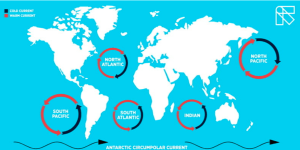North Atlantic Garbage Patch
By: Kayla Sucro September 30th, 2022

Have you ever heard of the North Atlantic Garbage Patch? Well if you haven’t, you should, because it is where about 10% of your plastic waste ends up. Every year we collectively consume 200 billion pounds of plastic and some of it ends up in the ocean. The plastic and other waste items make their way to the oceans where the currents sweep it up and swirl it into 5 major gyres. Today I am going to tell you about the not-so-pretty life cycle of your Starbucks cup.
All plastic comes from fossil fuels and is produced into small pellets called “Nurdles”. These Nurdles are the raw material for all things plastic so your Starbucks cup started off as a bunch of pea-sized pellets of plastic. These Nurdles are very small and hard to contain so when they get shipped across countries and oceans they spill onto highways where they get washed away into rivers that lead to oceans or they fall off shipping containers directly into the ocean. Since they are so small, they are extremely difficult to capture and recollect so they end up on beaches and in marine animals’ stomachs. Yes, the poor fishes and turtles are eating your plastic waste and it is not good for them. The plastic “fills” them up so they think they are satiated but really it’s just a bunch of plastic that has no nutritional value and they end up starved and most likely dead.
Once you are finished with your Starbucks cup you throw it into the recycling bin but someone else accidentally threw their trash in there so the entire bin is useless to the recycling center. So even though you did your part your Starbucks cup is still headed to the landfill. While the trash truck transports your cup, the wind blows your cup right into the river along the highway and a month later the cup has made its way into the ocean. When it’s there a current picks it up until it makes it into one of the 5 oceanic gyres and it gets stuck in a whirlpool of hundreds of thousands of other pieces of trash.
One of the 5 is the North Atlantic Garbage Patch which is right off the east coast of the US. Now, you can’t see it from satellites because it isn’t a dense “island” like many people think. The misconception that this is a floating island gives a false sense of how to attack the situation. It would be really hard just to scoop up all of the trash because it is a very large area, hundreds of kilometers, and only as dense as about 200,000 pieces of trash per square kilometer. These patches also act as marine animal “hubs” for breeding, socializing, and safety from predators so trying to scoop it all up in massive nets could harm wildlife more than it would help. Picking up piece by piece would take ages so the best way to fix the problem is at the source, stop using single-use plastics.
The plastic that ends up in the oceans slowly breaks down from the sunlight and gets very brittle and can break off into very small pieces called microplastics. Microplastics are much smaller than Nurdles at about 5mm or less in size which means they can reach a lot more places than Nurdles. Research has found that microplastics are in almost every human and you probably consume more than you think. 70,000 microplastic particles every year on average. 70,000 is a VERY large number, it comes from the food and drinks you consume and even the air you breathe. Depending on the amount of fish, sugar, salt, water, alcohol, and honey you eat/drink and if you are breathing urban air or not can change the amount of microplastics you consume but it is still a significant amount. The health effects of these microplastics are still widely unknown but they could be extremely toxic.
Single-use plastics are scary and all of the implications to them are even scarier and that is why you should limit the amount you use and consume. Any little change you make is a positive change and sometimes doing the best you can is all that matters. Single-use plastics are plaguing the environment and it is your responsibility to make a difference. Just one less Starbucks cup a year means 7 billion cups across the world that won’t end up in landfills and oceans.
Leave a Reply